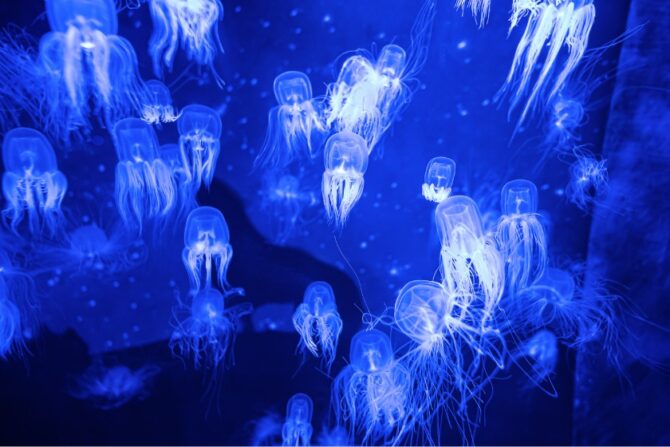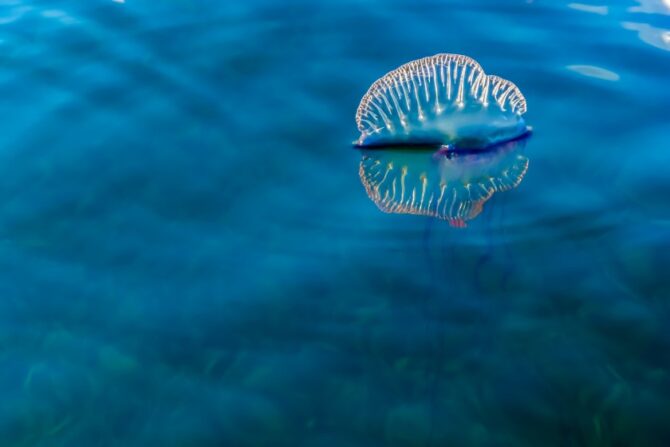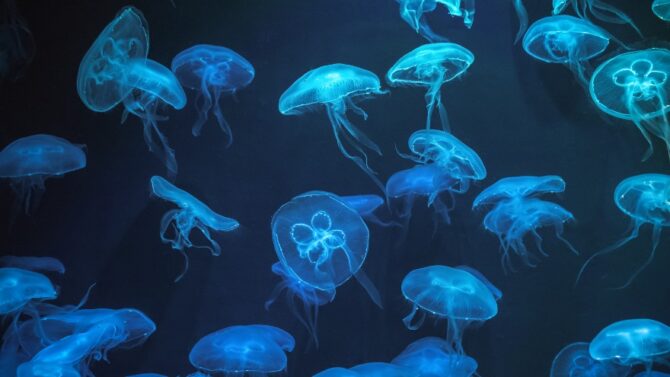No one talks about jellyfish without making it clear how they seem dangerous to be around or touch.
These marine invertebrates are one of the deadliest creatures in the world.1
The box jellyfish can kill in minutes while causing cardiac arrest in a few scenarios.
While many people are familiar with individual jellyfish, you may be wondering: what is a group of jellyfish called?
A smack is a term for describing a group of jellyfish, and it’s more like the oldest of all names. Other terms for these clusters include a bloom, swarm, or fluther.
These names have no scientific backing, but they are explanatory and suitable.
While jellyfishes are aquatic animals living in the sea, they can be seen in groups. Does that mean they live together or have some sort of schooling behavior?
This article will explore the answer to these questions and provide some interesting facts about jellyfish.
What is a Group of Jellyfish Called?

When it comes to a group of jellyfish, there are a few different terms that are used. The most common term is a “swarm” or “bloom” of jellyfish.
A swarm refers to a group of jellyfish that are all swimming together in the same area, while a bloom refers to a large group of jellyfish that are found in a specific location.
Other terms that are used to describe a group of jellyfish include a “smack” and a “fluther.”
Jellyfish can also be classified by their species; for instance, a group of Moon Jellyfish is called a “fluther,” and a group of Portuguese man o’ war is called a “float.”

Why is a Group of Jellyfish Called a Smack?
The word smack is an old name for describing these sea animals. Still, many people use it today.
Have you ever wondered why it’s important to know these names and why the above term became a popular one before becoming an old take?
Jellyfishes are dangerous and never to be toyed with. Whenever you see a group of these creatures moving closer to you, you should run for your life.
Imagine what will happen if you need to call for help but can’t seem to find the word for it.
Smack, in plain English, is a word for describing a sharp hit, blow, or slap that affects the body. Jellyfish exhibit such traits.
Their sting is so painful; you just might not get over it for weeks or even months.
They leave a sharp bruise on the skin and cause distress alongside severe injury. With no scientific backing, the term smack has gained popularity.
However, it isn’t as popular as it used to be, and a more reason why you should know the alternatives for this particular name.
Other Collective Nouns for Jellyfish Seen In Groups
You need to know what to call a group of jellyfish aside from the word ‘smack.’ Not so many are versed with this particular term.
So when you’re trying to describe a cluster or calling for help, the listener won’t be all surprised or confused. Other names for clusters of Jellyfishes include:
Bloom
Say you’re having a lovely time at sea, and you see blooming flowers approaching in your direction, run and find a safe space immediately.
These aren’t flowers. It’s called a bloom of jellyfish. The term ‘bloom’ has no scientific backing but is another suitable name for such clusters.
Blooms gather in a small space due to little or no accommodation. Such a gathering is usually rare.
However, it is likely to occur during spring when jellyfish are ideal for reproducing babies.
Planktons have just the same trait. You’ll find them in sparkling areas attracting these blooms of jellyfish.
Swarm
A swarm is used for a cluster of jellyfish of the same species. Although you can use the name however you like, it isn’t ideally suitable for jellyfish of different species.
The moon jellyfish likes to move in groups and might not move with a different species. Hence, it is usually referred to as a swarm.
Fluther
A fluther is another suitable name for clusters of these sea animals. Although it best fits any description that involves any type of jellyfish, this term is commonly used for box jellyfish.
The name above helps to describe a group of box jellyfish due to its rampancy in urban areas.
While most people still make use of this term, it is usually interchangeable with the word ‘bloom.’
What is a Group of Baby Jellyfish Called?
Most times, it’s those new Jellyfishes that you see forming a group. The older ones tend to move alone. Do you call these babies a bloom or a swarm?
Whichever way you put it, you’re right! However, these babies have their group name — an Ephyra. It comes with scientific backing.
Baby Jellyfish look harmless. Underestimate it, and you get to dance to the tune.
An ephyra emerges newly from polyps and develops into Medusa.2
How Many Jellyfish are in a Group?

Jellyfish blooms are entirely different compared to group names for other animals.
This is because it represents a cycle in their life when they transform from polyps.3
Yet, a bloom may consist of a thousand jellyfish. There is no exact number, but they are usually vast.
Do Jellyfish Live in Groups?
Jellyfish don’t live in groups. These animals have no schooling traits, and their gatherings aren’t for hunting or prey.
It appears that they come together unintentionally. These sea creatures are brainless. When they sting, they do it not because they want to.
They have no idea how it feels to the person affected. Jellyfish move in clusters to survive the water current.
A single species may not be able to swim and might float. However, when they move in thousands, the current becomes nothing.
Scientists are still yet to uncover the social life of these animals.
Conclusion
Jellyfish are fascinating creatures that are found in oceans all over the world.
They have a unique life cycle and are known for their distinctive bell and trailing tentacles, as well as their bioluminescent properties.
A bloom of jellyfish may look appealing, but they aren’t social. Even a dead one is bound to smack you when you touch it.
It is uncommon to see blooms in the sea during winter or summer.
Yet, when you do, you know better not to go nearby and call for help instead.
References & Notes
- What is the most venomous marine animal? National Ocean Service.
- Scyphozoa Ephyra. The Evergreen State College.
- Polyp and medusa body shapes. Te Ara Encyclopedia of New Zealand.

